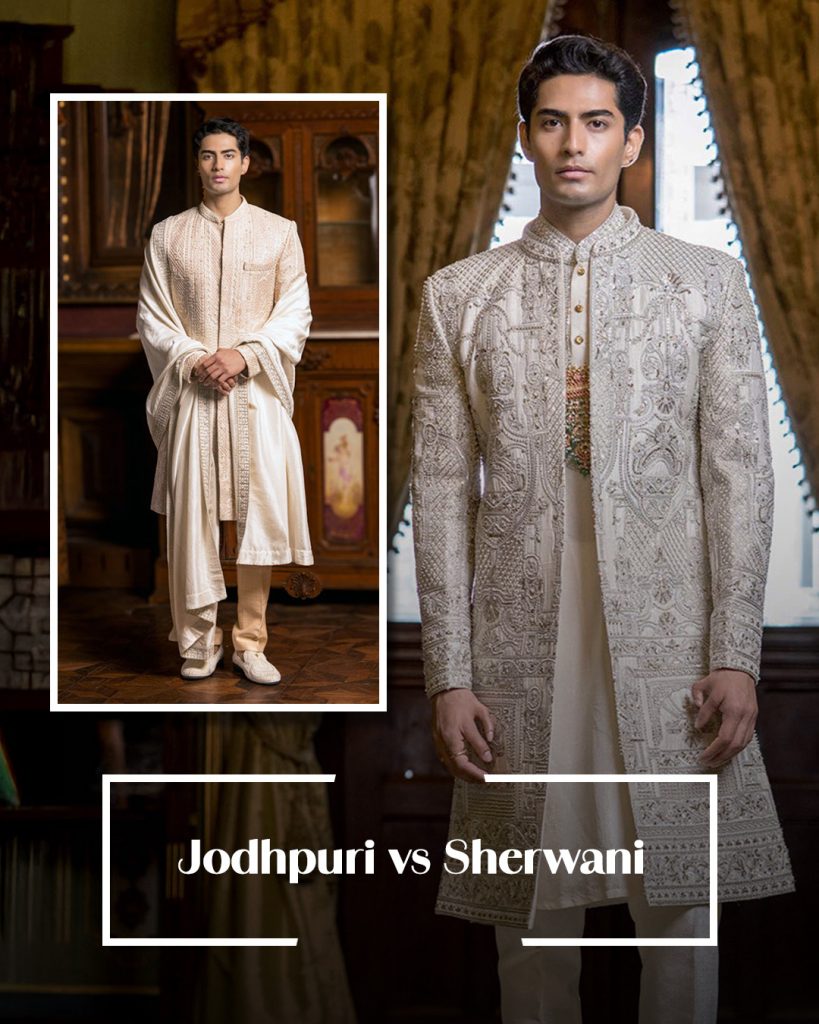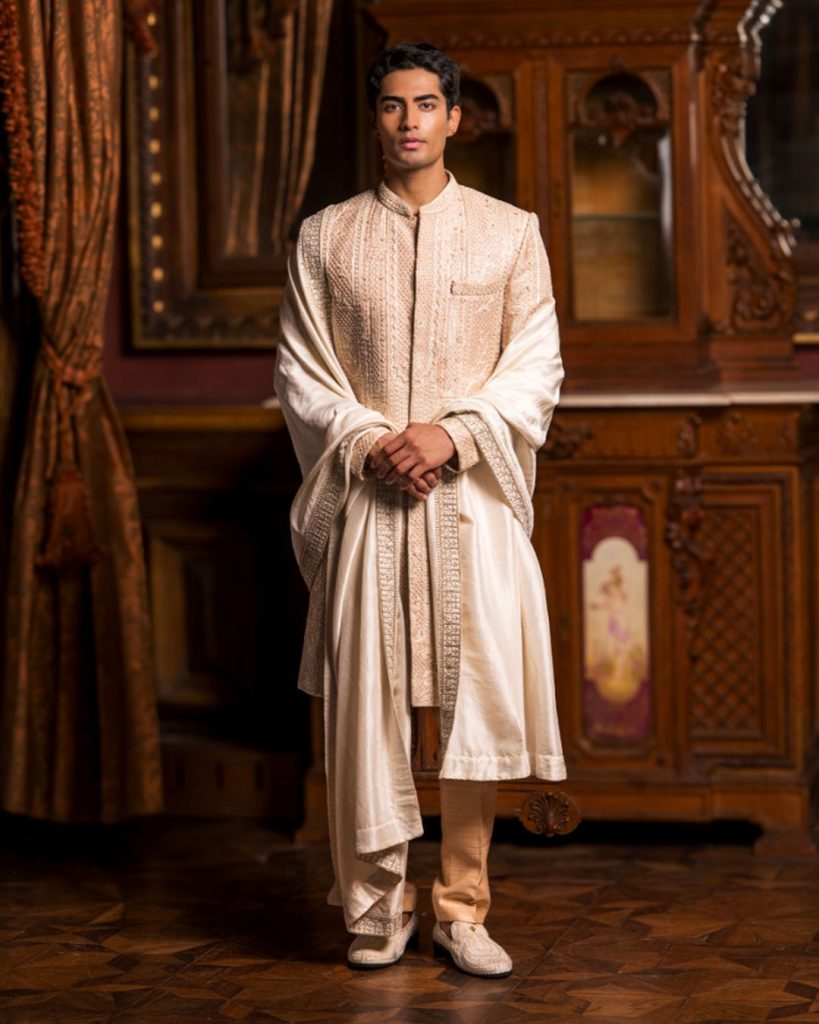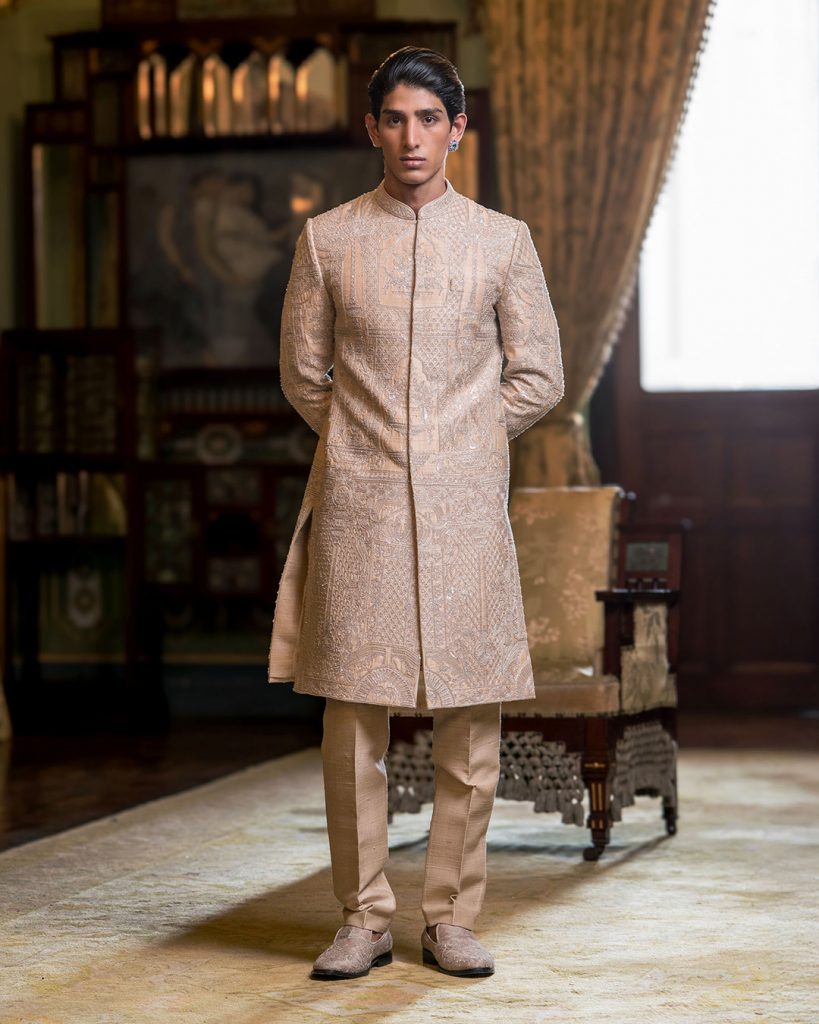
When it comes to Indian traditional wear for men, two names immediately strike our mind: Sherwani and Jodhpuri. The sherwani and Jodhpuri have been an integral part of the Indian culture, exuding sophistication and grandeur and showcasing the rich tapestry of textiles and Indian craftsmanship. But how do you choose between the two?
The best way to choose between the two is by learning about the difference between a sherwani and a Jodhpuri. In this article, we will explore some of the key differences between the two garments and help you make an informed decision based on your needs and preferences.
What is a Sherwani?
A sherwani is a traditional Indian attire, typically worn by grooms on their wedding day. It is a long coat-like garment, typically above-knee or knee-length, featuring a structured silhouette. Depending on the type of sherwani, it is often tailored from luxurious fabrics, with intricate embroidery and embellishments adorning it. It is often paired with a matching kurta, fitted pants or churidar and a stole for a complete look.
The elaborate outfit finds its roots in the Mughal era, when it was worn by royalty and aristocrats. But it was during the British era that it gained prominence with Indian royalty and gradually made its way out of the palaces and was adopted by the common man.
What is a Jodhpuri (Bandhgala)?
A Jodhpuri suit or a bandhgala is a semi-traditional attire for men. Compared to a sherwani, it is a shorter jacket, extending up to the hip level, sometimes even shorter. The contemporary-inspired suit features a fitted silhouette, a high-stable collar (bandhgala), and minimal embroidery, making it more comfortable to wear and suitable for a diverse range of events.
It originated in the 19th century in the princely state of Jodhpur, Rajasthan, by Maharaja Pratap Singh. He sought to combine Indian aesthetics with Western tailoring to create a garment that was both regal and functional.
Sherwani vs Jodhpuri: At a Glance (Comparison Table)
Feature | Sherwani | Jodhpuri |
| Length | Long (Below knee length) | Shorter (Up to hip-level) |
| Fabric | Luxurious Fabrics (Silk and Velvet) | Wider Variety (Cotton, Linen, Wool, and Silk) |
| Embroidery | Intricate Heavy Embroidery | Minimal Lightweight Embroidery |
| Silhouette | Flowing and Traditional | Tailored and Contemporary |
Comfort | Heavier and Restrictive | Lightweight and more comfortable |
11 Major Differences Between Sherwani and Jodhpuri

Silhouette and Length
A wedding sherwani is a long, knee- or calf-length coat with a buttoned front, flared silhouette and high collar. It features a tailored fit but is slightly looser than a sherwani.
A Jodhpuri, on the other hand, is a shorter jacket style that extends up to the hip level, featuring a high collar or bandhgala for a structured look. It is tailored to give the wearer a sleek and polished look, accentuating their physique.
Fit and Structure
Sherwani features a loose but structured silhouette that flares out at the bottom. However, a bandhgala features a fitted silhouette that sits close to the body, creating a sleek, contemporary look.
Bottom Wear Pairing
Sherwanis are best paired with matching churidar, straight-fit pants or dhoti pants for a traditional wedding look. Jodhpuri suits can be styled with tailored trousers or breeches to achieve a royal look.
Fabrics and Materials
Both sherwanis and Jodhpuris are tailored from luxurious fabrics. However, the choice of fabrics is different for both. Sherwanis are tailored using silk, jacquard, brocade, and velvet to match celebratory occasions, such as weddings. Since Jodhpuris are a semi-traditional garment, they are often made from lighter fabrics such as silk, linen and lightweight suiting materials.
Embellishments and Design Work
Engagement sherwanis are worn for special occasions and thus feature intricate embroidery, such as zari work, beads, and sequins detailing, showcasing traditional motifs. Typically, Jodhpuris feature lightweight embroidery and embellishments, but heavy embroidery is not uncommon.
Occasion Suitability
Sherwanis are best suited for opulent occasions such as weddings, religious ceremonies and festive celebrations. However, Jodhpuris are more versatile and can be worn for weddings, formal events such as cocktail parties and receptions, and even business gatherings or cultural events.
Comfort and Mobility
Sherwanis are longer and feature heavier embroidery and fabrics, making them more restrictive when worn for extended hours. While an integral part of the Indian wedding ceremony, sherwanis are best suited for colder months and shorter durations. Another comfortable traditional wear option for men is kurtas. You can read about the differences between a sherwani vs kurta in our blog.
Compared to sherwanis, Jodhpuris are more practical and lightweight to wear. The shorter length and lightweight structure make it easy-to-wear formal attire for various occasions and climates.
Styling and Accessories
A sherwani is best paired with a safa, a kalgi and a stole or shawl. Other non-negotiable accessories that should not be missed are a pair of suitable footwear, a traditional necklace, and possibly a watch.
A Jodhpuri is best paired with a statement brooch or a pocket square and a safa, if it is a wedding ceremony. Other accessories that enhance your Jodhpuri look are suitable footwear, a classic watch and a suitable pair of sunglasses for daytime events.
Regional and Cultural Associations
Sherwanis showcase Indian craftsmanship and are worn by Indian grooms all across the globe for their wedding day as well as for other cultural events.
While Jodhpuris represent Rajasthan’s cultural heritage, these are also worn by Indian men all across the globe for special events and occasions.
Price and Tailoring Complexity
The price range for both sherwanis and Jodhpuris may vary depending on various factors, such as the fabric, craftsmanship, brand and more. However, reception sherwanis are comparatively more expensive than Jodhpuris, as they are more elaborate in terms of stitching, embroidery and embellishments.
How to Choose: Jodhpuri vs Sherwani for Your Wedding?

If you are a groom, a sherwani is the ideal choice for you, as it provides an outfit with a traditional and majestic vibe for your special day. Choose a sherwani that symbolises cultural grandeur and aligns with the elaborate traditional celebration. You can also choose an achkan sherwani for a minimal wedding look. Learn more about the differences between a sherwani and achka in our blog, achkan vs sherwani.
Jodhpuris are best saved for occasions beyond the wedding, especially if you are the groom. The best occasions to wear a Jodhpuri are pre-wedding occasions, such as the sangeet ceremony or mehendi ceremony.
Conclusion
Both the sherwani and Jodhpuri are great traditional wear options to commemorate any event. However, the one you pick truly depends on your choice and fashion preferences. Both garments offer a completely different aesthetic and comfort level, and it honestly comes down to your personal appeal.
FAQ’s
What is the main difference between a sherwani and a Jodhpuri?
There are several differences between a sherwani and a Jodhpuri. However, some of the major factors that differentiate the two include the design, fabric choices, fit and structure, occasion suitability, comfort level, silhouette and length and even the cost.
Which is better for the wedding ceremony: a sherwani or a Jodhpuri?
A sherwani is more suitable for the wedding ceremony, as it complements the aesthetic and grandeur of the occasion. However, you can also wear a Jodhpuri for a small, intimate wedding.
Can a groom wear a Jodhpuri for pheras?
Most grooms prefer to wear a sherwani during the pheras. But if you want, you can choose to wear a Jodhpuri for a minimal and comfortable fit.
How should a sherwani fit?
A well-tailored sherwani should fit you just right, without being too tight or too loose. It should fit you snugly over the torso and gradually flare out towards the hem for a sophisticated yet grand look.
Can a sherwani be worn without a turban?
Yes, you can wear a sherwani without a turban if you are not the groom or if you are attending an event other than a wedding.